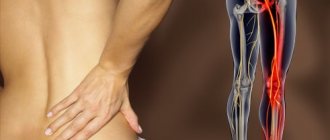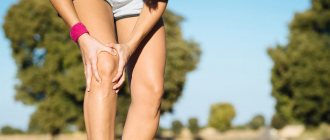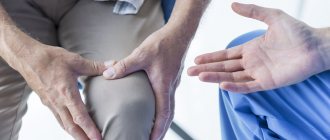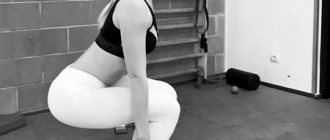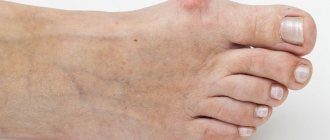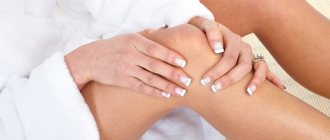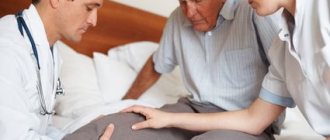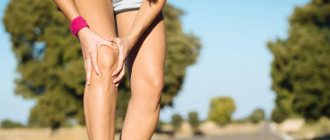Joints hurt due to weather conditions - the body's ability to react to temperature changes and changes in atmospheric pressure. In medicine, the syndrome is called articular meteopathy. Aches are more often experienced by people with a history of musculoskeletal diseases: osteochondrosis, arthritis, arthrosis or osteoporosis. The body's painful reactions should not be ignored. If discomfort occurs when the weather changes, you should consult a doctor to prevent degenerative changes in cartilage tissue.
Causes of pain
To understand why the joints of the limbs, back and neck react to “bad” weather, you need to remember that the human body contains water (80%). It is not only in the blood and lymph, but also in the synovial fluid. This is the name of the physiological substance necessary to lubricate joints. If it is not enough, there is a crunch, pain when moving and destruction of cartilage tissue.
The expansion and contraction of blood vessels depends on pressure, which also affects the joints
When weather conditions change, atmospheric pressure changes, which affects the internal pressure in the human body. The blood supply to the vessels supplying the joint joints changes, swelling appears, and nerve bundles are pinched. As soon as the body gets used to the new state, the aching pain subsides.
But not everyone experiences exacerbations in wet, rainy weather. Factors influencing the deterioration of the condition:
- obesity - more often “twists” the knees when there is an increased load on them;
- poor nutrition or unbalanced diet - due to a lack of nutrients, metabolic processes at the cellular level are disrupted, cartilage tissue becomes thinner;
- flat feet, congenital anatomical pathologies of the knee and pelvic joints - improper load distribution;
- increased activity, or, conversely, sedentary work - muscle and joint overstrain.
Meteor dependence is aggravated if there is a history of lumbar or cervical osteochondrosis, rheumatoid arthritis, arthrosis, arthritis, gout.
Symptoms of articular meteopathy
Patients affected by weather changes describe the condition differently. The sensations are characterized by aching, pain, twisting, aching. Doctors diagnose exacerbation of osteochondrosis of the cervical or lumbar spine, arthritis or arthrosis of the knee, elbow joint, phalanges of the upper and lower extremities.
Meteor dependence worsens the general condition. Due to swelling of the soft tissues, peripheral and large vessels are pinched, oxygen supply to the brain decreases, weakness, nausea, and headache appear. It is difficult to fall asleep, and semi-fainting may occur periodically. The hands and phalanges of the fingers, feet, and large joints swell. When the weather changes, it is better for women to abandon the rings, otherwise it will be difficult to remove them later.
The fair sex is more sensitive to weather changes. They have thinner bones and are dependent on the functioning of the hormonal system. It is disrupted when atmospheric pressure changes.
In patients, due to constant discomfort, irritation increases and an inexplicable feeling of anxiety appears. Because of this, relationships with others may worsen. The overall quality of life decreases.
- Causes of aching pain in the knee joint at rest. What to do if your knees ache
Treatment options
The deterioration of the condition cannot be ignored if, when the weather changes, chronic pathologies of bone and cartilage tissue worsen and pain appears. Such symptoms indicate the development of degenerative-dystrophic processes. The treatment is comprehensive, in addition to medications, the course includes physiotherapy, and special nutrition is recommended. It is possible to use traditional methods.
Medications
It is advisable to use pharmaceuticals according to medical recommendations. The drugs relieve pain, restore metabolic processes in the joints, increase the body's immunity, and help resist the aggressive influence of external factors.
Often prescribed:
- Teraflex Advance. The drug contains analgesic and antipyretic components (ibuprofen, glucosamine) and chondroitin, a chondroprotector that stimulates the regeneration of cartilage tissue.
- Nonsteroidal anti-inflammatory drugs (NSAIDs) - Ibuprofen, Nimesulide, Nise, Diclofenac. They have analgesic and anti-inflammatory effects and are available in tablets and ointment (gel) form. Internal use is limited - no more than 5-7 days. They have a pronounced side effect - an aggressive effect on the gastric mucosa.
- Humisol is a biogenic stimulant that enhances the body’s resistance to external influences.
- Analgesics - Analgin, Paracetamol, Baralgin. Relieves acute painful sensations.
- Gepar-Joint. A drug that eliminates swelling and normalizes lymphatic drainage.
- Ointments with analgesic and warming effects: Nicoboxil, Efkamon, Finalgon, Apizartron with bee venom or Capkotox with snake venom. These remedies have a beneficial effect on osteochondrosis if the condition worsens due to increased stress.
Frequent exacerbations of rheumatoid arthritis may require consultation with a physician or infectious disease specialist. The disease may have an infectious etiology and, if the pathogen is not suppressed, the destruction of the joints cannot be stopped.
Warming up
Thermal procedures on an outpatient basis relieve pain and reduce inflammation. Compresses made of paraffin, ozokerite, and warm medicinal mud are applied to problem areas; Warming hydrogen sulfide or radon baths are recommended to patients. At home, the joints are rubbed with alcohol (with the addition of pepper), bags of warm salt and millet are applied, an iodine mesh is applied, or a pepper patch is applied.
Before doing home warming, it is advisable to consult a doctor. Heat can increase swelling.
Nutrition correction
If pain in the joints and back occurs, it is advisable to switch to a diet that normalizes metabolic processes. It is necessary to avoid hot, spicy and fried foods, products with extractive substances - chocolate, strong broths, alcohol, marinades, offal and canned food. Limit the use of refractory fats and vegetables from the nightshade family - tomatoes, eggplants, potatoes.
Increase the amount of fluid you drink to 2 liters per day using diuretic teas and mineral water. It is useful to supplement the diet with infusions of rose hips, currant leaves, and green tea. It is recommended to increase the amount of fermented milk products.
Traditional methods
To relieve exacerbations, healers advise using home remedies:
- Pine nut tincture. The shells are calcined in a frying pan, poured into a bottle of vodka, filling a quarter full. Infuse for 3 weeks in the dark at room temperature, shaking 2 times a day. Strain and put in the refrigerator. Dosage regimen: 3 drops on day 2, 5 on day 2 and increase the dose to 22 drops. Reduce the dose in the same sequence. The course of treatment is repeated after 3 days.
- Bay tincture. 10–12 laurel leaves are poured with boiling water, 900 ml, left overnight in a thermos. Strain and put in the refrigerator. The mixture is drunk for 3 days.
- A compress of grated horseradish or steamed birch leaves. Apply to the sore joint for 2–3 hours.
- Apple cider vinegar lotions. Can be left overnight.
When using home remedies in the form of mixtures, you should consult your doctor. Folk remedies are not always combined with pharmaceuticals.
Dress warmly
Always choose clothes according to the weather. It is strictly forbidden to expose the body (especially joints) to hypothermia. However, it is important not to overheat the body. If pain in the joints is caused by an inflammatory process, then excessive heat will accelerate the progression of the disease.
It is best to provide several layers of clothing. The lowest one should fit snugly to the body.
Eat right
Avoid various diets (if they are not prescribed by doctors) during cold weather. Any restrictions in the diet undermine the body's protective functions. A weakened immune system is unable to resist inflammatory processes.
It is advisable to enrich your menu in autumn-winter with products rich in:
- manganese (rice, beans);
- zinc (beef, eggs, peanuts);
- calcium (milk, sardines, hard cheeses);
- phosphorus (fish, meat);
- silicon (lentils, beans).
Temper yourself
This recommendation allows you to gradually accustom your joints to the effects of cold. But you can start to harden only in the summer. Otherwise, you can independently provoke hypothermia with all the ensuing consequences. If your joints periodically bother you, then you can start hardening your body only after consulting a doctor.
Take care of your joints, always protect them from the cold, visit a traumatologist in a timely manner (even if falls and bruises seem insignificant to you), and they will serve you faithfully.
Why does a change in weather cause joint pain?
Knee pain
When the disease is advanced to the point that the cartilage wears out and no longer protects the bone, the load falls on the bone tissue. They are significantly stronger than cartilage, are injured during movements and lead to arthrosis, a component of which is degenerative changes in cartilage and bone tissue. This leads to knees hurting before the rain and reacting to any changes in the weather.
Causes of changes in joint tissues:
- What to do if your knees and hip joints hurt and ache
- unbalanced nutrition - lack of amino acids, glycine, vitamins C, minerals K, Ca in the diet. At the same time, the cartilage becomes thinner and reacts sharply to changes in weather. The condition cannot be neglected - the degeneration of cartilage and bone tissue will begin to progress;
- excess weight is an additional factor in weather dependence; high load only accelerates the destruction of cartilage;
- flat feet disrupts the distribution of load, which causes gradual deformation of the joints of the knee and hip;
- high physical activity, careless attitude to stress, especially in professional activities. Or vice versa - immobility, a sedentary lifestyle, negatively affect the state of the musculoskeletal system;
- arthrosis, arthritis, osteochondrosis - these diseases are always accompanied by meteoropathy, as a result, metabolic disorders intensify.
A person with meteoropathy always predicts the approach of warming or cold weather, wind or precipitation earlier than meteorologists, because his knees begin to hurt from the weather, ache and twist all his joints.
Symptoms of meteopathy
Meteopathy
Patients describe pain and joint reaction to meteorological changes in their own way. Indeed, meteoropathy manifests itself differently in each person. Some complain of specific pain in the joints, others have joints that ache and “twist”, while others have limited range of motion. Symptoms of pain occur during movement and at rest. Most often, knees ache due to the weather, but complaints are also made of pain in the neck, lower back, knee joints, and phalanges of the fingers.
Symptoms of articular meteopathy:
- headache, restless sleep; dysfunction of the central nervous system is caused by deterioration of blood supply associated with swelling of the soft tissues in the neck;
- lethargy, weakness, emotional decline; the reasons are the same - oxygen starvation;
- feeling of anxiety, abdominal pain; the psychological state negatively affects somatic changes in well-being;
- swelling of the fingers and toes; the reason is that when large joints swell, blood vessels and capillaries are compressed, and peripheral blood supply is disrupted.
How to help a weather-dependent person
When joints hurt when the weather changes, this can be considered a “chronic condition,” but doctors consider it inappropriate to endure pain and wait for the body to adapt. Moreover, the weather is constantly changing, from season to season, from rainy days to windy ones. The vagaries of the atmosphere are taken into account even in ICD-10. Here a place is given to maladaptive reactions of the body that have a special nature.
This, of course, is not a special section on meteodependence and meteopathies, however, acute reactions and disorders of adaptive reactions are coded as F43.0, F43.2.
Teraflex Advance
The body reacts to climate change with pain in the joints, and doctors suggest not to suffer from discomfort, but to begin targeted treatment. For this purpose, the pharmaceutical arsenal has a whole list of medications that are sure to help with joint pain. A targeted course of treatment can be carried out if the doctor deems it necessary.
You can take medications as symptomatic help, directly when pain occurs:
- Teraflex Advance - the appearance of pain in joints of any localization is used as an anesthetic. This is a complex drug that includes glucosamine, chondroitin and ibuprofen. In addition to pain relief, the medicine has a therapeutic effect due to its chondroprotector.
- Ibuprofen is a non-steroidal drug that quickly relieves joint pain.
- Diclofenac, Movalis - non-steroidal anti-inflammatory tablets. They have anti-inflammatory, antipyretic, analgesic properties. You can take them for no more than 3-5 days, because they have an aggressive effect on the mucous membranes of the digestive organs. Contraindications to taking these drugs are mucosal erosion and ulcers.
- Humisol is a stimulant of the biogenic group with an adaptogenic effect; With its intake, the body’s natural defenses “come to life” and resistance to biological effects increases.
- Virapin - an ointment with warming and analgesic properties, contains cobra venom; Gevkamen ointments containing camphor and levomenthol have the same effect; Apizartron containing bee venom.
- Gepar-Sustav is a homeopathic medicine in capsules that contains 24 active components. It has an effective therapeutic effect; with its regular use, salt deposits dissolve, swelling is relieved, and the condition of connective tissue is normalized. As a result, healing, rejuvenated joints stop responding to weather changes.
- Cavinton and Lucetam are long-acting drugs that improve blood circulation, including peripheral one.
- Analgin and Paracetamol are traditional painkillers that help relieve pain.
- Barbiturates – drugs in this group help with sleep disorders, difficulty falling asleep, and shallow sleep.
- Rumalon, Artra, Chondroxide – a group of chondroprotectors; have a prolonged effect. The effect of taking them appears no earlier than six months later, when the condition of the joints improves and blood circulation normalizes. The joints will become healthy, strong, and completely get rid of meteoropathy. Drugs in this group do not have a pronounced analgesic effect, and therefore are not suitable for the symptomatic relief of acute pain.
Additionally, it is recommended to use folk remedies that actively relieve painful symptoms in the joints, heal the body, and increase its immune strength.
Many people report joint pain due to the weather. And if in some people this pathological condition indicates weather dependence, in other cases the body’s ability to respond to changes in atmospheric pressure may indicate serious diseases. That is why, when your joints regularly twist, ache or ache, it is recommended to go to a medical facility and undergo a diagnostic examination.
Main reasons
Women are more prone to joint pain than men, but absolutely everyone who has chronic diseases suffers from painful joint discomfort. People who have previously suffered limb injuries will have to deal with pain in bone joints when weather conditions change. But joints in patients with arthritis, rheumatism, osteochondrosis and arthrosis also react to changing weather. The legs hurt severely before rain or snow due to damage to the nerve endings, as a result of which the sensitivity of the joints increases and the person becomes more susceptible to changes in temperature outside or air humidity.
- Why do joints hurt due to the weather?
The medical explanation for why your legs drag or your knee hurts when the weather changes is as follows:
Rain can cause swelling in the joint area.
- When it rains, the oxygen level increases, causing people to experience swelling in problem joints.
- During temperature changes, people experience severe leg pain due to the ability of atmospheric pressure to change. As a result, its levels in the joint cavity decrease or increase.
- When the weather changes, the nerve endings are irritated and the joint receptors are activated, so the knee begins to ache and become weak.
Return to contents
When it's cold outside
With the approach of the autumn-winter period, many people begin to experience exacerbations of chronic diseases. Pathologies of the musculoskeletal system (MSA) are especially acute. Basically these are various disorders in the joints.
Patients over 60 years of age most often suffer from such exacerbations. However, recently, as doctors note, the pathologies of the musculoskeletal system have become significantly “younger”. Today, various disorders are found in 30-40 year old people.
Doctors believe that the main reasons for the early development of musculoskeletal diseases are:
- hereditary predisposition;
- past (or chronic) infections;
- excess weight, which creates stress on the lower limbs;
- unhealthy diet;
- injuries received.
How does the symptom appear?
When the weather changes, people describe their condition differently. Typically, patients complain of aching joint pain that occurs during movement or at rest. In addition, knees may ache, bones may break and twist. The joints of the legs and arms often hurt, but painful discomfort is also noted in the cervical or lumbar spine.
People with joint weather sensitivity often experience other symptoms, the most common of which are the following:
Headache is often a sign of weather sensitivity.
- worsening sleep;
- pain in the temples and back of the head;
- weakness and lethargy;
- painful syndrome in the abdomen;
- swelling of the hands and toes;
- irritability.
Return to contents
Why is it dangerous?
Unserious, at first glance, joint pain in people who react to the weather can conceal dangerous diseases. Thus, painful sensations in the joints, which many consider to be the cause of weather dependence, are often a symptom of rheumatism. And moderate pain and morning stiffness before rain may indicate the development of cartilage tissue diseases. By not taking these symptoms into account, people are at risk of developing serious complications and deteriorating their own health. There is a danger of loss of joint mobility and the need for surgery, which consists of replacing the affected joint with an artificial one.
Persons who are often bothered by pain in the joints when the weather changes are advised to consult a doctor to determine the cause of the pain and, if necessary, receive the correct prescriptions.
Return to contents
help yourself
First of all, you should correct your own lifestyle, i.e. pay attention to compliance with the following rules:
- Normalize your sleep duration.
- A complete diet, excluding overeating and abuse of “junk” food.
- Smoking, drinking alcohol and drinking large amounts of coffee during the day. Take all this away.
- If pulling and aching sensations develop closer to the feet, valerian extract in tablet form or another herbal tranquilizer is recommended.
Diagnostic methods
The doctor will definitely give you a referral for a general blood test.
Before the doctor prescribes a therapeutic regimen, he must conduct an examination and write out directions for a diagnostic examination. To make a correct diagnosis, the doctor will need the results of a general blood test, radiography, and ultrasound. If diagnosis is difficult, it is recommended to perform arthroscopy, which will help identify the pathology and determine the cause of the painful reaction of the joints to changing weather.
Return to contents
What to do: 3 main tips
If you feel the negative impact of cold on your joints, you should immediately make an appointment with a doctor. Very often, sensitivity to weather changes is the first (and sometimes the only) symptom of musculoskeletal pathologies. Don't forget: the sooner you go to the doctor, the sooner treatment will begin. And it is much more successful in the initial stages of the disease.
To protect your joints from the damaging effects of cold, follow these tips.
What to do?
Traditional methods
When a bone joint reacts painfully to fluctuations in atmospheric pressure or precipitation, doctors recommend taking painkillers. The following non-steroidal PS (anti-inflammatory drugs) will cope well with this symptom:
- "Movalis";
- "Ibuprofen";
- "Diclofenac".
The listed medications, in addition to the ability to stop the inflammatory process, have the ability to relieve pain and normalize body temperature. However, they should be used no longer than 5 days, as they can have an aggressive effect on the mucous membrane of the digestive tract. Analgesic ointments with a warming effect show excellent results for joint pain:
Apizartron ointment will help cope with pain.
- "Apizartron"
- "Gevkamen";
- "Virapin."
When the joints are twisted before the rain, doctors advise using chondroprotectors. But you shouldn’t expect a quick result from them, so it’s not advisable to use them to eliminate acute pain. The positive effect of these medications appears no earlier than six months after the start of the therapeutic course.
Return to contents
Folk remedies
Proponents of alternative treatment recommend rubbing with potato sprouts for joint weather conditions. To do this, you need to pour sprouted potato seeds into a bottle of vodka, filling the container 2/3 full, and leave to infuse in a dark place for 2 weeks. Traditional healers also recommend treating joint pain with a cabbage leaf, which should be washed, beaten and applied to the problem area.
Bibliography:
- https://ortocure.ru/kosti-i-sustavy/boli-i-hrusty/na-pogodu.html
- https://nogostop.ru/koleno/chto-delat-esli-bolyat-sustavy-na-pogodu.html
- https://etosustav.ru/diskomfort/vazhno/boli-v-sustavah-k-peremene-pogody.html
Traditional methods
The express method is a hot bath based on a decoction of chamomile flowers. The latter should be prepared as follows: pour 50 g (about three tablespoons) of medicinal herb into 1 liter of water and boil for a quarter of an hour. Then leave the broth for 2 hours and add warm bath water.
As a method of treatment, local (on the “twisting” area) use of an ordinary cabbage leaf can be used, then it should be fixed and such a compress should be maintained for several hours.

